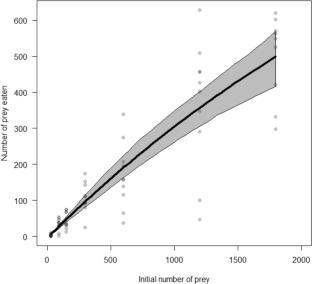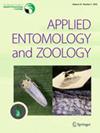Voracity of Nesidiocoris tenuis (Hemiptera: Miridae) for Bemisia tabaci (Hemiptera: Aleyrodidae) and Thrips palmi (Thysanoptera: Thripidae) and its functional response to the density of B. tabaci
Abstract
Nesidiocoris tenuis (Reuter) (Hemiptera: Miridae) is a zoophytophagous mirid predator that has recently been commercialised for augmentation biological control in Japanese greenhouses. This predator species is expected to control both Bemisia tabaci (Gennadius) (Hemiptera: Aleyrodidae) and Thrips palmi Karny (Thysanoptera: Thripidae) on vegetables grown in greenhouses throughout Japan. Studies on the predatory efficacy of N. tenuis are essential for assessing the effectiveness in terms of biological control in greenhouses. The voracity (the daily maximum predation) of N. tenuis for B. tabaci and T. palmi of different stages and the functional response to the density of B. tabaci nymphs were assessed in a controlled environment. Nesidiocoris tenuis nymphs and females exhibited high voracity for both B. tabaci nymphs and T. palmi larvae. Females reached peak voracity at 462.4 ± 72.8 on B. tabaci first-/second-instar nymphs. The voracity of N. tenuis nymphs increased with the development and that of fifth instar nymphs were not significantly different from females. Nesidiocoris tenuis females reached peak voracity (61.9 ± 5.2) on T. palmi second-instar larvae and both the fourth-instar nymphs and females of N. tenuis showed higher voracity for T. palmi second-instar larvae than for T. palmi adults. Moreover, the N. tenuis females exhibited a type III functional response to the density of B. tabaci first-/second-instar nymphs. The voracity and the functional response will be used as input to a prey–predator models for the quantitative evaluation of biological control by N. tenuis in greenhouses.


 求助内容:
求助内容: 应助结果提醒方式:
应助结果提醒方式:


